Changing leaves, cooler weather, the scent of pumpkin spice — break out the flannel, Autumn's here! For many, that might mean back to school, but even if not, it's a great time to refocus your Japanese studies. Here's some of the best Japanese learning resources that were new to us over the past few months. So get cozy and get studying!
- Migaku Pitch Trainer
- Pokémon Kids TV Japan
- JLPT Grammar List and Example Sentences by Chika Sensei's Japanese Academy
- JPDB.io
- Immersion Kit
- Speak Japanese Naturally
- 週末の酒がうまい、BRUTUSの聞くレシピ
- AxTongue
- にほんごで働く!ビジネス日本語30時間
- RiceBurger Studios
- Let’s Learn Japanese with Movies Podcast
- Kanji Adventures for Gamers and Vtuber Fans by Nihongo Picnic
Migaku Pitch Trainer
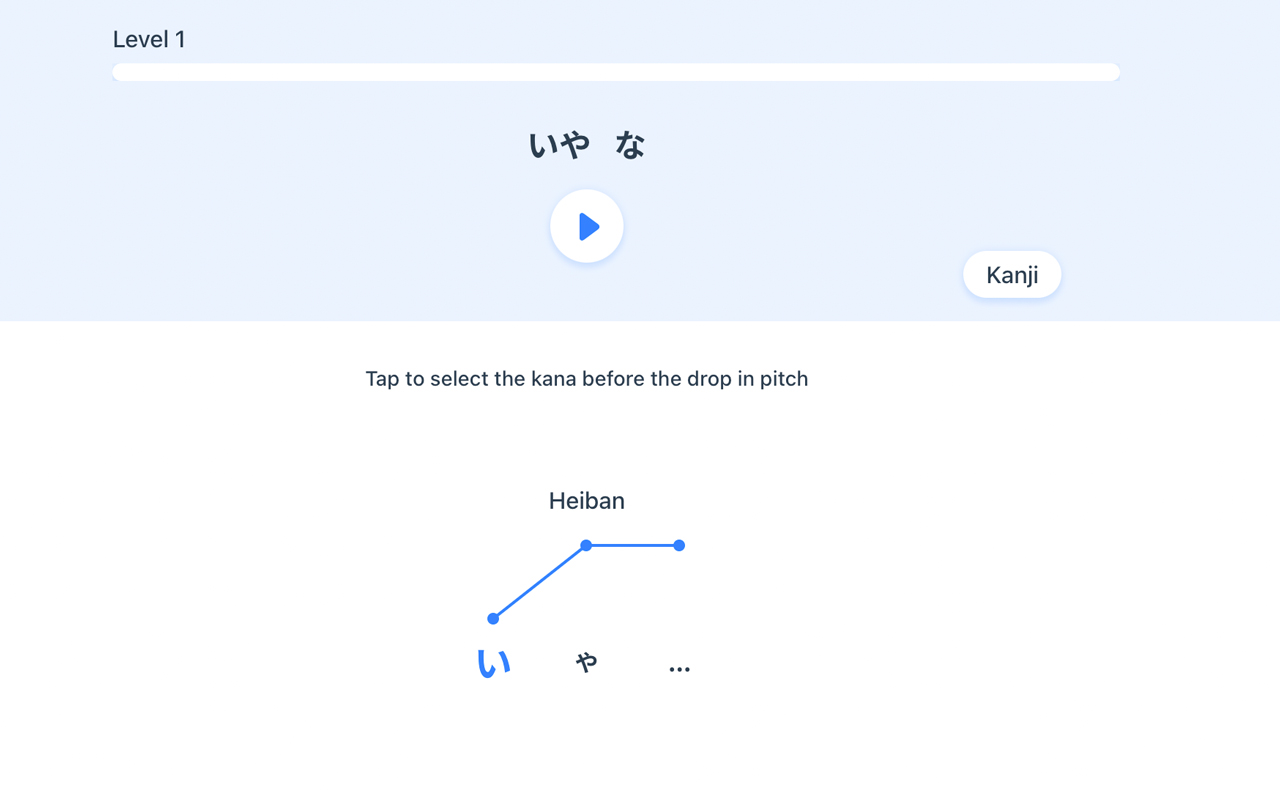
Have trouble getting the pitch of that word just right? This is where Migaku Pitch Trainer comes in! With both a free and paid version, users can take lessons and practice training their ears to distinguish between different types of pitch accents used when pronouncing Japanese words. Unlike some other apps with fantasy words to focus on pitch or computer-generated recordings, Migaku Pitch Trainer uses real Japanese words, and has recordings by native speakers.
The home page contains four main areas: Learn, Train Now, Custom Session, and Achievements. Near the bottom are links to a placement test, as well as a reference guide. Many of these features are free to use to a point, but some (like the Custom Session and placement test) require a paid account from the get-go. Later lessons also require a paid account. For the overall design and quality, it seems like a site worth using. And the audio sound quality is great which makes being able to distinguish between different pitch patterns easy.
Some of the audio files may not play immediately upon being clicked, and some of the recordings may cut off at weird places, but other than that, this site is a great place to get in some pitch accent practice. The addition of a fluid interface and an achievements section really add to the appeal of the site. Going through the lessons is fun, and you can really feel the improvement in your pitch accent skills.
Pokémon Kids TV Japan

Pokémon-loving learners of Japanese, rejoice! If you didn't know already, there is a Pokémon-themed YouTube channel with lots of great videos in Japanese (and English) that may be useful for listening practice and immersion. Videos are designed for kids, so the Japanese used in each one is relatively simple, slow, and many videos come with Japanese subtitles!
There are a number of different kinds of videos. The channel currently boasts 23 different playlists ranging in content from ASMR, to exercise videos, to stories, and more. The Experience Adventure playlist is also very educational. Ever want to learn more about airplanes and pilots? There's a video for that! What about sumo or dentistry? There are videos all about those too.
Even though these videos are aimed at Japanese children, they can be very valuable to learners of Japanese as well. The inclusion of subtitles in Japanese helps viewers confirm what they are hearing, and can serve as a way to encounter new vocabulary. It's fun to use Pokémon Kids TV to learn new words in context. Learners looking to improve their listening skills can use the audio as listening practice, while confirming later with subtitles. But learning aside, the videos on this channel are top-notch quality and overall enjoyable to watch. The abundance of topics also means that there is just about something for everyone to enjoy!
JLPT Grammar List and Example Sentences by Chika Sensei's Japanese Academy
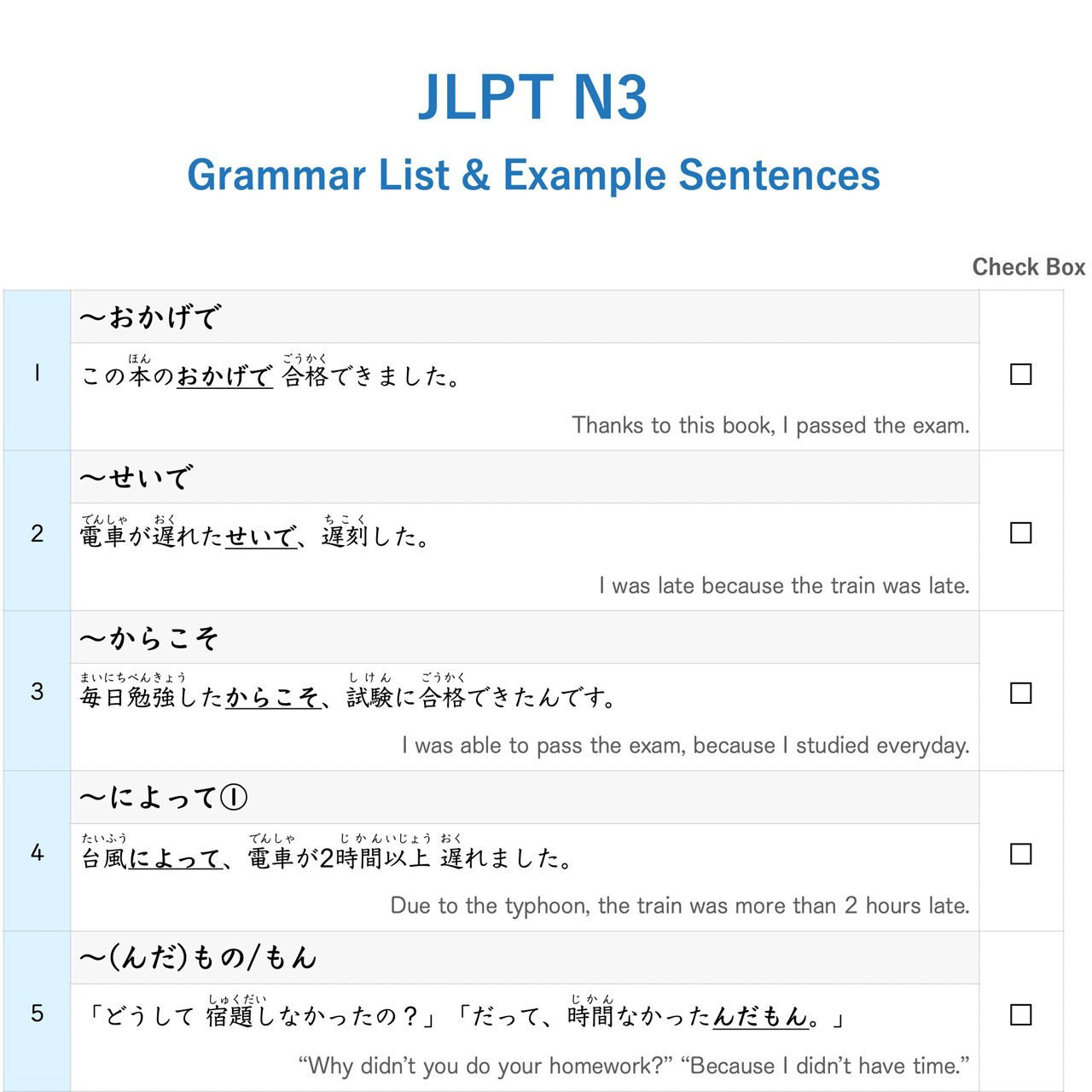
Chika Sensei's Japanese Academy is a site dedicated to helping Japanese learners study for the Japanese Language Proficiency Test (JLPT) at all levels. They offer a range of services, from private classes to grammar explanation videos on YouTube. Now, Chika Sensei has a list of Japanese grammar points into documents differentiated by JLPT level. By submitting your name and email address at her website, you will be sent an email containing links to these grammar lists free of charge.
The lists themselves are high quality, and contain a large amount of grammar structures. In every level, she demonstrates each point with an example sentence. At lower levels (N5-N4), she includes an English equivalent of the grammar structure, as well as an English translation of the example sentence in Japanese. And in the N1 lists, all English goes away and is instead supplemented by multiple example sentences in Japanese. It seems that N1 learners get some tough love here, as they will have to look up each grammar point via other resources if they desire an explanation.
A major plus about these grammar lists is the fact that there is a checkbox for every grammar point. This allows learners to physically check off any grammar structure they think is mastered. Paper-and-pen studiers may particularly enjoy this feature. And arguably the best part about these lists is that they are all free. To create such a nice, useful resource and put it out on the Internet in this way is absolutely amazing.
JPDB.io

JPDB.io is a web app combining a rich Japanese native material database with an SRS to learn the vocabulary for anime, dramas, novels, and more; before you dive in to immerse yourself. Many Japanese learners are familiar with using reading or other native material to learn Japanese as it’s used in context, from grammar to vocabulary. However, rather than making flashcards from words you don't know from a book you're currently reading, for example, JPDB.io allows you to learn and review the words you don't know before even opening the cover.
Combined with this novel approach to vocabulary building is a full-featured Japanese media database. While other sites offer lists of various recommended books or TV series for Japanese learners, by combining this with an SRS that knows your vocabulary, JPDB.io is able to offer recommendations for media that should already be very comprehensible to you.
It's still in active development, so it’s not quite perfect yet, but JPDB is quickly becoming a one-stop-shop for Japanese learners who want to build their vocabularies and practice with native media all in one place.
Immersion Kit
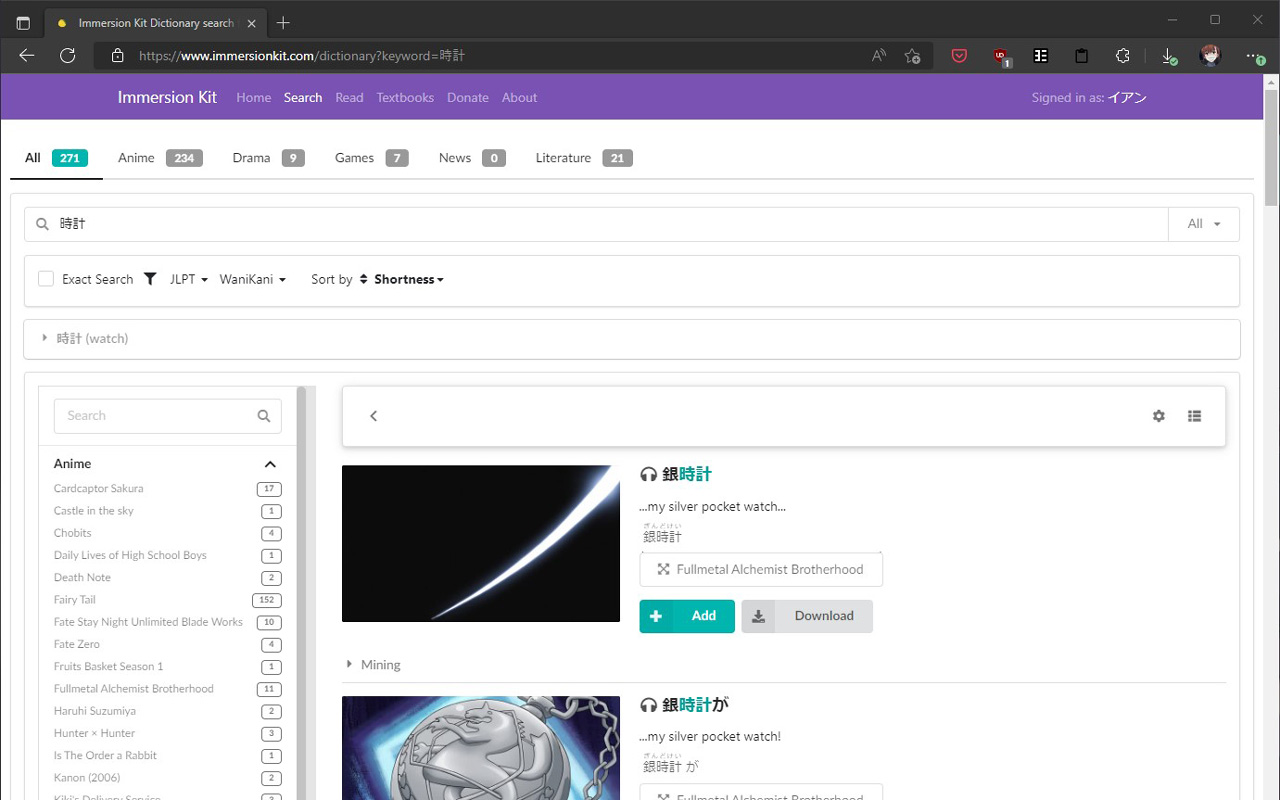
Ever find a Japanese word out of context, and want an example sentence you’ll actually remember? Or find a word in a novel, news article, or out in the world, and want something a little more dynamic to make a flashcard out of? Look no further than Immersion Kit!
Immersion Kit is a dictionary site containing over 400,000 different Japanese sentences from various anime series. Additionally, every sentence has a screenshot from that moment in the anime, as well as the audio of the line from the show. From there, users can download entire flashcards to add to their Anki decks, or just the audio or picture if you’d like to make your own.
By default, the sentences are sorted by length, with the shortest appearing up top, but you can filter by JLPT level, WaniKani level, or even the anime it comes from (if you wanted to make a deck with only sentences from Fullmetal Alchemist Brotherhood, for example). The anime database is by far the largest, though sentences from dramas, games, news, and literature are slowly being added as well. All in all, Immersion Kit is a great site for Japanese learners who appreciate seeing words in context to learn.
Speak Japanese Naturally
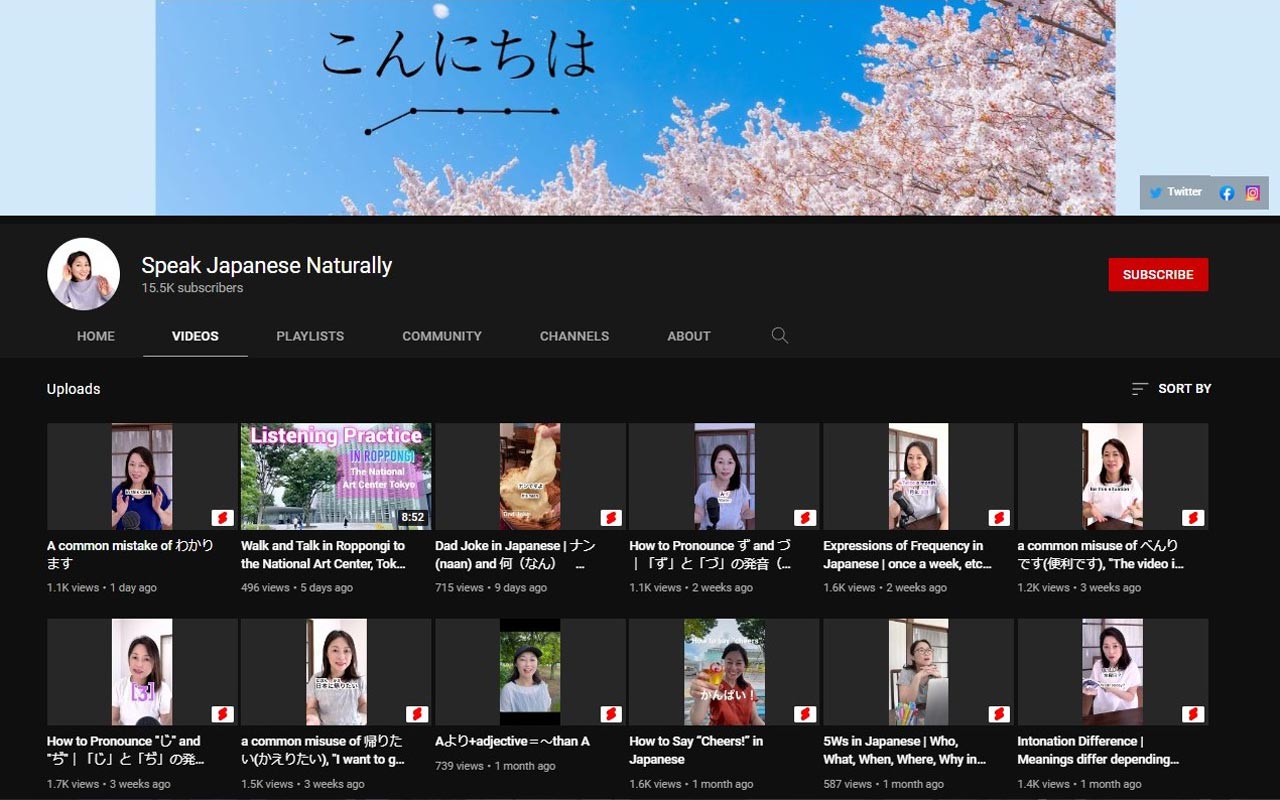
Speak Japanese Naturally is a Japanese-language learning YouTube channel launched in June of 2020. The host, Fumi, offers a wide range of instructive videos, focusing on grammar, pronunciation, and as the name implies, getting closer to how Japanese is actually spoken rather than "textbook language."
Fumi uses a ton of different sources, from interviews, music, and anime, to help convey her explanations. These explanations are offered in English, making Speak Japanese Naturally a great channel for even beginner or lower-intermediate Japanese learners.
While pitch accents, pronunciation, and natural phrasing are cornerstones of Speak Japanese Language, the content isn't quite as honed in as some channels, which might only focus on grammar, for example. But on the other hand, this keeps videos feeling fresh, offering a spread of videos interesting to many different types of learners. If you want to make your Japanese sound a bit more natural, or just want to mix up your YouTube rotation, give Speak Japanese Naturally a try!
週末の酒がうまい、BRUTUSの聞くレシピ

Cooks and foodies alike are in for a treat with the Brutus Weekend Cooking podcast, 週末の酒がうまい、BRUTUSの聞くレシピ. If you’re not yet familiar with BRUTUS, it's a Japanese lifestyle magazine with articles on fashion, travel, and more. Each of these podcast episodes is around 20 minutes long and focuses on one dish and one beverage that pair nicely together. The podcast hosts and occasional guests discuss how to make the food and drink as well as related topics, like the best place to enjoy these meals.
Unlike a cooking video, where viewers can watch the cooking techniques and mimic them later, the lack of visuals forces you to test your listening comprehension. If you've been wanting to learn more cooking-related terminology, this will be a good opportunity for you to hear more about how to mix, chop, or sauté in Japanese. The speed of the conversation is relatively slow despite being a podcast for native speakers. Japanese learners from upper beginner on will be able to enjoy this series.
Each podcast episode is also accompanied by an article on the menu, which you can find on the BRUTUS website under the "Cook" or 料理する section. The articles are in Japanese and include the recipe as well as some beautiful photos of the pairings. Listen before your next dinner party and see how your creation turns out!
AxTongue
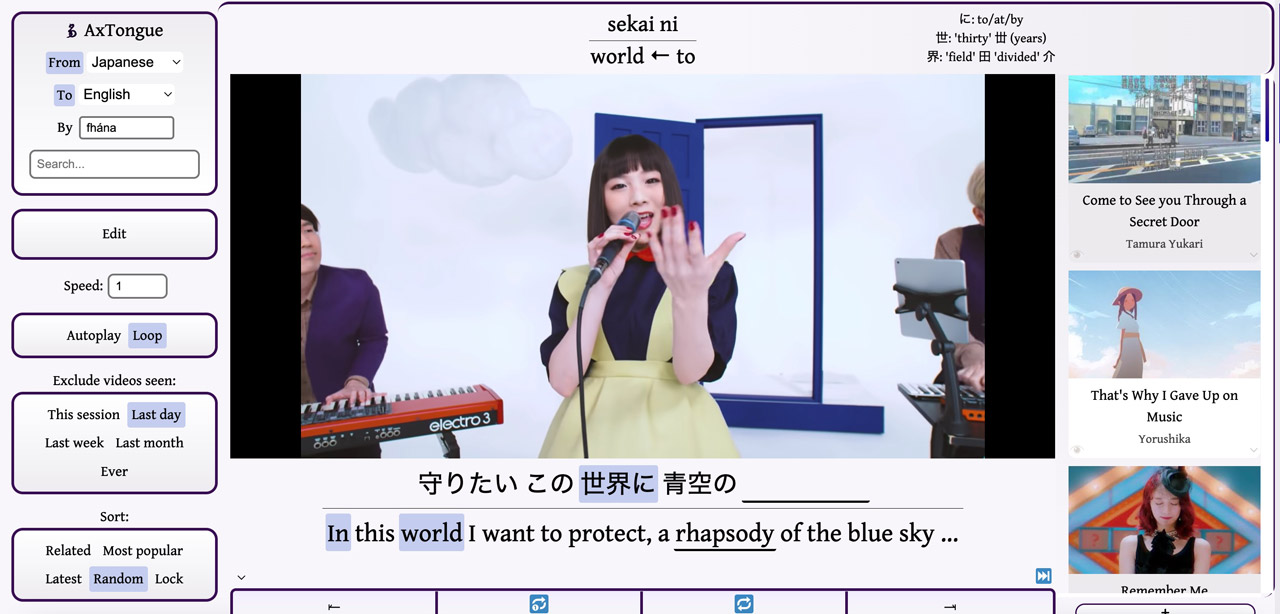
Do you learn best through music? Are you a fan of Japanese karaoke? If so, AxTongue could be a resource you want to know about. AxTongue is a website that features YouTube videos of Japanese songs with user-submitted lyrics in both Japanese and English. That means that you can listen to Japanese songs and practice the language at the same time.
While watching a music video, you can follow along with the captions conveniently displayed below. The highlighted portion of the Japanese lyrics will correspond to the highlighted portion of the English lyrics. There's an added element of learning with some words removed from the lyrics, and later revealed when that part is sung. There are also more detailed explanations in the upper corner for specific grammar and word help.
Currently, AxTongue primarily features songs, but also includes some language learning conversation videos as well. This resource could be used by any level of learner but is particularly good for upper beginners and intermediate learners. Whether you'd like to give these songs a listen or contribute your own lyrics to a video, head on over to their site.
にほんごで働く!ビジネス日本語30時間

Have you ever thought about working for a Japanese company? Does the thought of using honorific speech and strict business mannerisms scare you? If so, you may want to check out にほんごで働く!ビジネス日本語30時間 (meaning Work in Japanese! Business Japanese in 30 Hours). Originally published in 2009, this book was updated in early 2022. Like your standard business Japanese textbook, it makes sure you are well-versed in using honorific speech (keigo) and provides plenty of opportunities to practice through sample conversations and role-play activities.
Separated into eight chapters, you will learn what to do and say at a Japanese company in a number of situations: taking phone calls, asking requests, receiving permission, making appointments, and more. Each chapter begins with a warm-up quiz, special expressions, and business-related vocabulary. Then it goes into short interactions, which become the basis of longer conversations in the following section. After that is a role-play section, a practice section (with an emphasis on honorific speech), and finally, a business column in which aspects of Japanese business culture and manners are explained.
As the title indicates, the entire book can be completed in just 30 hours if you dedicate around 3-4 hours per chapter. The design is minimalistic and completely in monochrome which may not be ideal for some learners. It also does not directly teach you honorific speech in each chapter; an explanation of honorific speech is provided in the back of the book.
That said, it does include a separate word booklet with English, Chinese, and Korean translations of all the vocabulary and phrases, which is convenient for people who dislike having to flip to the glossary in the back of the book when they want to look up a word. Additionally, furigana is used above every kanji, so that every word is readable. Plus, all vocabulary presented in each chapter includes pitch accent information. This is valuable for learners who wish to sound as native as possible. And as with many textbooks, there is an accompanying CD with native recordings of all of the sample conversations.
While the minimalist, wordy design may not be everyone's cup of tea, the amount of content and features packed into this book is definitely worth the price. There's a consistent flow throughout, and the business culture information at the end of each chapter is really valuable. According to the teacher information at the front of the book, this text's difficulty is somewhere around JLPT N2 and above. If you are studying for those tests (or just for business Japanese in particular), then this book may be just what you are looking for.
RiceBurger Studios
If you’re looking for some cute and entertaining videos to watch to learn Japanese, RiceBurger Studios has you covered. These videos can be found on both their YouTube channel and Instagram page, with slightly different content depending on the platform. The main two characters, Oni and Han – derived from the words onigiri and hanbāgā — are a talking riceball and hamburger duo that teach Japanese in a fun and approachable way. This is similar to their creators, two friends whose imagination inspired the voices and animation behind it.
The videos that RiceBurger offers cover various topics like helpful conversational phrases, casual speech, grammar points, and other exercises. Most of these videos are under two minutes in length so you can breeze through them quickly. In these videos, the characters use a mix of Japanese and English. Oftentimes, there are captions to go along with the dialogue in both languages as well. Learners who are around intermediate level will find this the most helpful, but these can be viewed and enjoyed by almost all learners.
Let’s Learn Japanese with Movies Podcast

Any film buffs out there? The Let's Learn Japanese with Movies Podcast is a podcast designed for people just like you! The way it works is there are three parts to the resource — the film, the podcast, and the transcripts of the podcast. You can choose the order of operations here based on what you'd like to focus on. The films are short, mostly award-winners, and in various languages, including silent films.
Each film is broken down into multi-part podcast series where the host, Aki, discusses the film in slow and simple Japanese. The speed and level of vocabulary makes this a good podcast for beginner learners, which it's intended for. The episodes are all about ten minutes long and are entirely in Japanese, except for the occasional English translation word used to help listeners. There is also a Q&A session during the podcasts where Aki asks the listener questions based on what's been said, motivating the listener to pay close attention to the details. Give it a watch, a listen, and a read!
Kanji Adventures for Gamers and Vtuber Fans by Nihongo Picnic
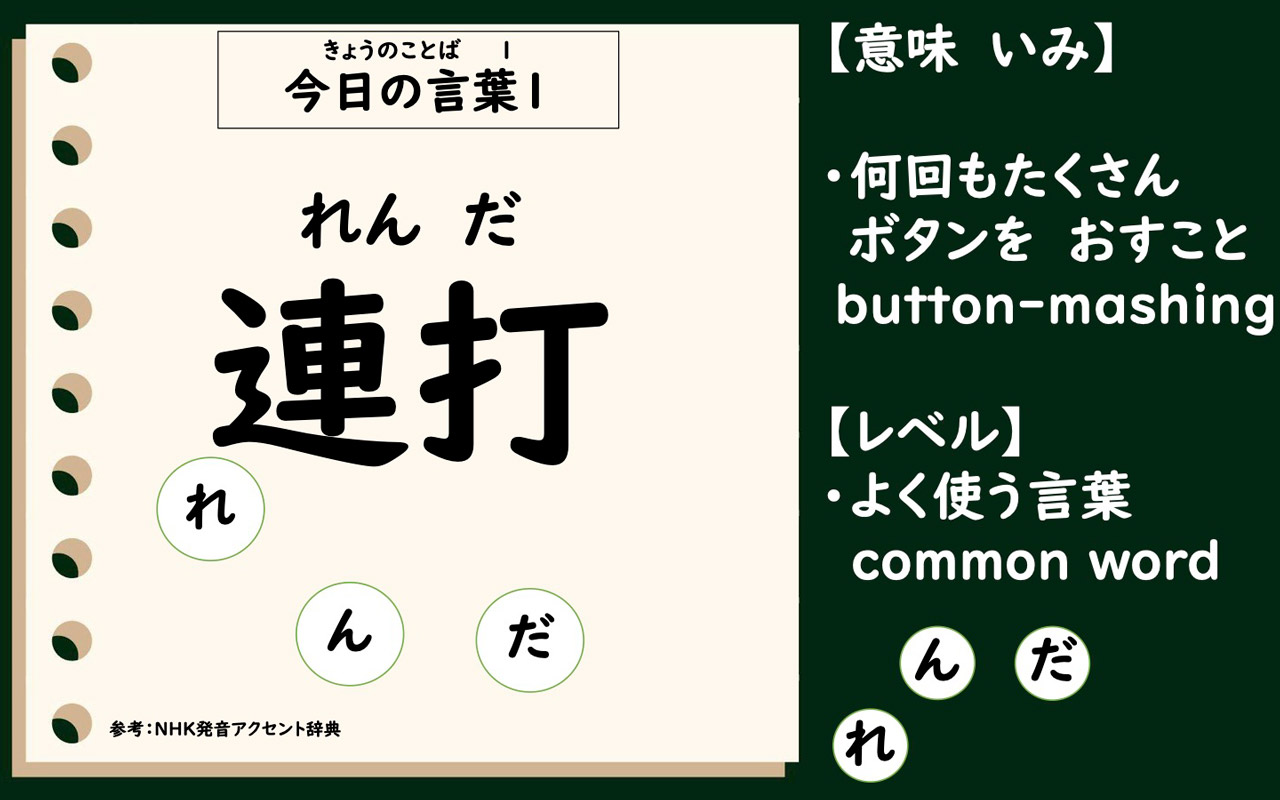
Kanji Adventures for Gamers and Vtuber Fans is an online course by Nihongo Picnic, a Japanese language school that offers a variety of different courses geared towards the JLPT, business Japanese, kanji, and more.
The class is geared towards learners around the JLPT N3 level but can accommodate learners at the N4 and N2 levels as well. Words with kanji that are common in the Japanese gaming and vtuber (short for virtual YouTuber — someone that makes videos on YouTube using a virtual avatar) communities make up the main content of each lesson. And while word meanings and usages are broken down, the real focus is on their kanji. The entire course covers about 140 kanji and lasts three months, meeting once a week. English is often used by the teacher to explain difficult concepts.
A typical lesson will open with a theme and short discussion. The theme for the sample class was ゲームスキル (game skills) and introduced six words made up of two kanji each, totaling 12 kanji to be learned in that session. For example, we covered two words: 連打 (renda, button-mashing) and 裏技 (urawaza, hidden move or life hack).
Learners are first taught how to pronounce each word using standard pitch-accent based on the NHK pitch accent dictionary. Then, kanji for each of these words are broken down into their individual components and memory hints are provided (similar to what WaniKani does). Learners are also given a chance to write each character on the screen. Once each character is broken down and the full word can be recognized, there is a short conversation that utilizes the word in question. Students are given a chance to practice the dialogue with other students and the teacher. When the class finishes going through all of the words for that lesson, homework is assigned. The class also references WaniKani a lot, offering students a coupon code, and optional homework connected to the app; though being a WaniKani user is not required.
We sampled this Kanji Adventures for Gamers and Vtuber Fans class and it was highly enjoyable; the instructor was very understanding and really made sure all the students were accommodated. The colorful slides, and opportunities to use what one has learned are a huge plus that learners of any level will benefit from.
The course can seem a bit pricey, but that stems from the fact that Nihongo Picnic offers small courses with certified professional, native Japanese teachers. If you would like online lessons with a small class size, Nihongo Picnic likely has something you can take for the right price.
While that might be all for this edition, the fun doesn't have to stop here! Should you happen across any other great resources, send us an email at hello@tofugu.com, or reach out to us on Twitter @tofugu. We love hearing from you, and finding new study resources to share together!
